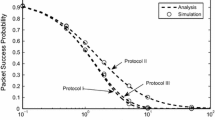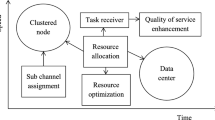Abstract
In this paper, a procedure for dealing with the multi-user synchronisation problem in Orthogonal Frequency Division Multiple Access (OFDMA)-based systems for ad hoc environments is proposed and analysed. We show with this novel approach that it is possible to re-use much of the already extent literature for single-user synchronisation in OFDM and apply it to multi-user ad hoc scenarios. Also a distributed version of the procedure is proposed in order to fairly share out the power consumption among all the devices. The proposed procedure makes use of higher layer capabilities in a cross-layer design and it does not incur too much complexity or power. This issue is specially critical in wireless heterogeneous ad hoc networks where devices can be very limited in terms of transmission and/or computational power.
Similar content being viewed by others
References
Moeneclaey M., “The Effect of Synchronization Errors on the Performance of Orthogonal Frequency Division Multiplexed (OFDM) Systems”, Proc. of COST 254 (Emergent Techniques for Communication Terminals), July 1997.
Robertson P., Kaiser S., (1999) “The Effects of Doppler spreads in OFDM(a) Mobile Radio Systems”. Proc. IEEE Vehicular Technology Conference VTC Fall, 1: 329–333
A.G. Armada, V.P. G. Jiménez, and J. Darriba, “Analysis of Phase Noise Effects in Multi-User OFDM”, Proc. IEEE First Internatinal Symposium on Control Communications, and Signal Processing (ISCCSP), March 2004.
Moose P., (1994). “A Technique for orthogonal Frequency Division Multiplexing Frequency Offset Correction”. IEEE Transactions on Communications, 42(10): 2908–2914
Schmidl T.M., Cox D.C., (1997). “Robust frequency and timing synchronization for OFDM”. IEEE Transactions on Communications, 45(12): 1613–1621
Yang B., Letaief K.B., Cao R.S.C.Z., (2000). “Timing Recovery for OFDM transmission”. IEEE Journal on Selected Areas in Communications (JSAC), 18(11: 2278–2291
Minn H., Bhargava V., Letaief K., (2003) “A Robust Timing and Frequency Synchronization for OFDM Systems”. IEEE Transactions on Wireless Comunications, 2(4): 822–839
de Beek J.-J., Borjesson P.O., Boucheret M.L., Landstrom D., Arenas J.M., Odling P., Ostberg C., Wahlqvist M., Wilson S.K., (1999). “A Time and Frequency Synchronization Scheme for Multiuser OFDM”. IEEE Journal on Selected Areas in Communications (JSAC) 17(11): 1900–1914
Zhou D., Lai T.-H., “Analysis and Implementation of Scalable Clock Synchronization Protocols in IEEE 802.11 ad hoc Networks”, Proc. of IEEE International Conference on Mobile Ad-hoc and Sensor Systems, Fort Lauderdale, (Florida), Vol. 1, pp. 255–263, 25–27 October 2004.
Kleider J., Gifford S., (2002). “Synchronization for Broadband OFDM Mobile ad hoc Networking: Simulation and Implementation”. Proc. IEEE International Conference on Acoustics, Speech, and Signal Processing (ICASSP), 4, 3756–3759
“PACWOMAN: Power Aware Communication for Wireless OptiMised personal Area Networks (IST-2001-34157), Proposal”, 2001. (www.imec.be/pacwoman)
“IEEE 802.16a: Air interface for fixed broadband wireless access systems. amendment 2: MAC modifications and additional Physical Layer specifications for 2-11 GHz”, ISBN 0-7381-4069-4, IEEE Standard, 2003.
A.G. Armada, V.P.G. Jiménez, M.J. Fernández-Getino, and J.L. García, “H-OFDM Design for Wireless Personal Area Communications”, Proc. IST Mobile Summit, 2003.
“WLAN Medium Access Control (MAC) and Physical Layer (PHY) specifications: High-speed physical layer in the 5 GHz Band”, ISBN 0-7381-2695-0, IEEE Standard, No. 802.11a, June 2001.
V.P.G. Jiménez and A.G. Armada, “Bit-loaded H-OFDM to Increase Capacity in WLAN/WPAN”, Proc. IEEE Vehicular Technology Conference VTC Fall 04. Los Angeles., Vol. 1, No. 1, September 2004.
Jiménez V.P.G., García M.J.F.-G., Serrano F.J.G., Armada A.G., (2004).“Design and Implementation of Synchronization and AGC for OFDM-based WLAN Receivers”. IEEE Transactions on Consumer Electronics, 50(4): 1016–1025
Morelli M., Mengali U., (1999) “An Improved Frequency Offset Estimator for OFDM Applications”. IEEE Communications Letters, 3(3): 75–77
Park B., Cheon H., Kang C., Hong D., (2003). “A Novel Timing Estimation Method for OFDM Systems”. IEEE Communications Letters, 7(5): 239–241
Minn H., Zeng M., Bhargava V., (2000). “On Timing Offset Estimation for OFDM Systems”. IEEE Communications Letters, 4(7): 242–244
Hass Z.J., Deng J., (2002). “Dual Busy Tone Multiple Access (dbtma)-a Multiple Access Control Scheme for ad hoc Networks”. IEEE Transactions on Communications, 50(6): 975–985
Wu S.-L., Tseng Y.-C., Sheu J.-P., (2000). “Intelligent Medium Access for Mobile ad hoc Networks with Busy Tones and Power Control”. IEEE Journal on Selected Areas in Communications (JSAC) 18(9): 1647–1657
C. Ware, T. Wysocki, and J. Chicharo, “Hidden Terminal Jamming Problems in IEEE 802.11 Mobile ad hoc Networks”, Proc. IEEE International Conference on Communications. ICC, Helsinki (Finland), Vol. 1, pp. 261–265, 11–14 June 2001.
Gelenbe E., Pujolle G., (1995). Introduction to Queueing Networks, 2nd edn. plus John Wiley & Sons
Qian L., Krishnamurthy A., Wang Y., Tang Y., Dauchy P., Onte A., (2004). “A New Traffic Model and Statistical Admission Control Algorithm for Providing QoS Guarantees to on-line traffic”. IEEE Global Telecommunications Conference. GLOBECOM, 3(29): 1401–1405
Author information
Authors and Affiliations
Corresponding author
Rights and permissions
About this article
Cite this article
Jiménez, V.P.G., Armada, A.G. Multi-user Synchronisation in ad hoc OFDM-based Wireless Personal Area Networks. Wireless Pers Commun 40, 387–399 (2007). https://doi.org/10.1007/s11277-006-9198-3
Published:
Issue Date:
DOI: https://doi.org/10.1007/s11277-006-9198-3




